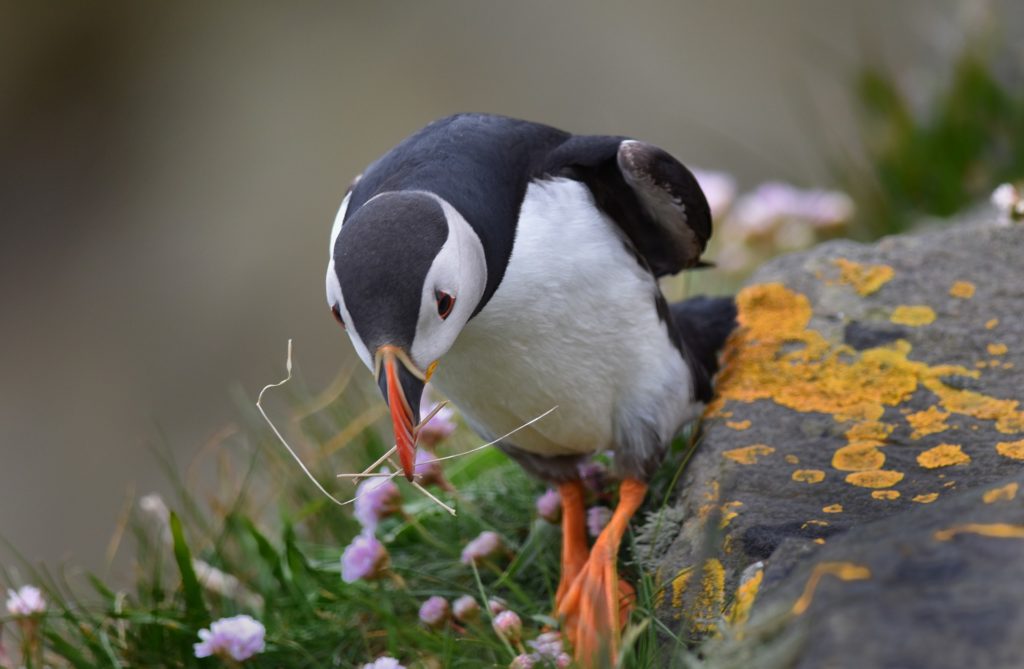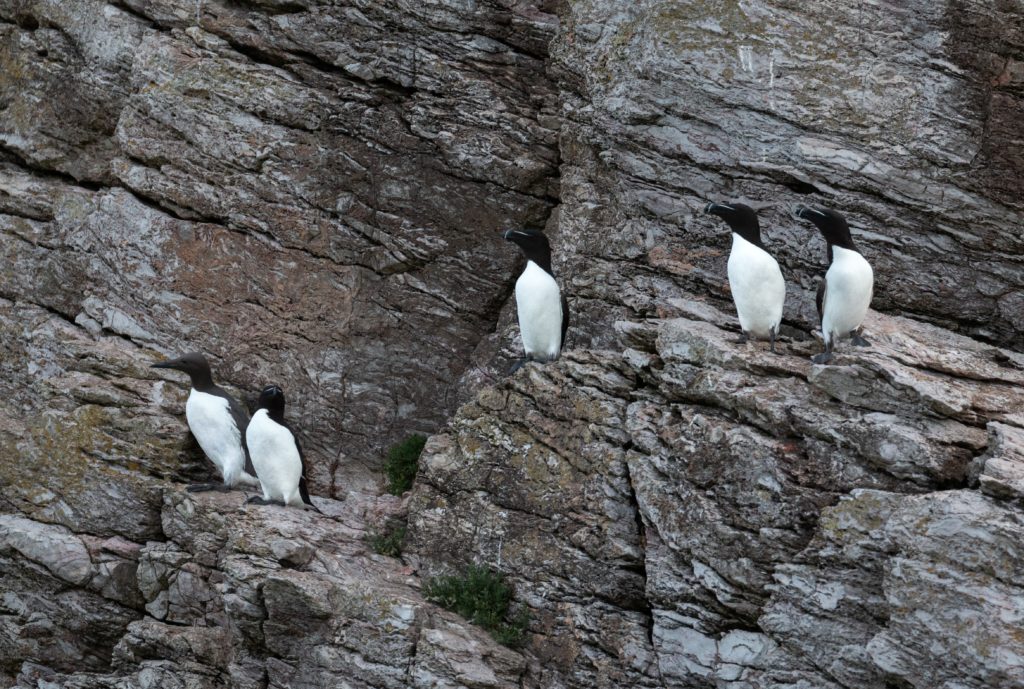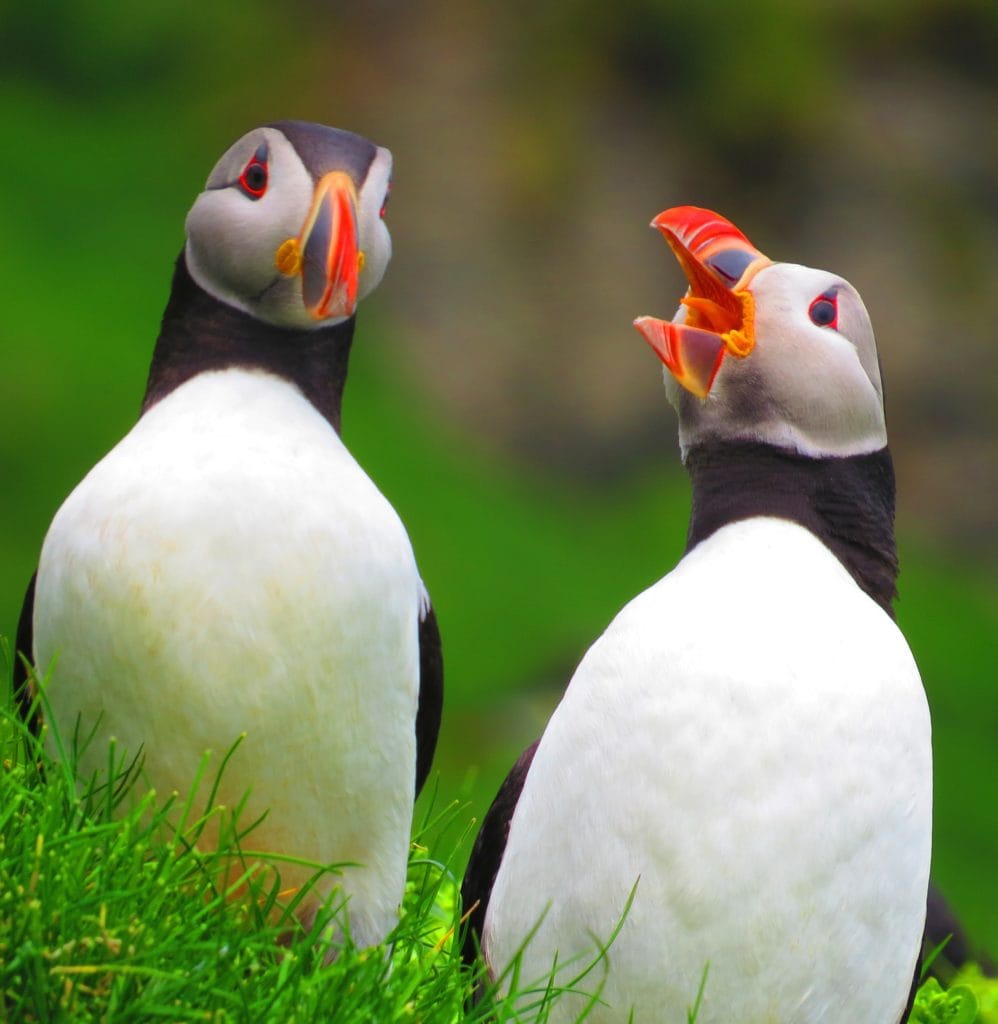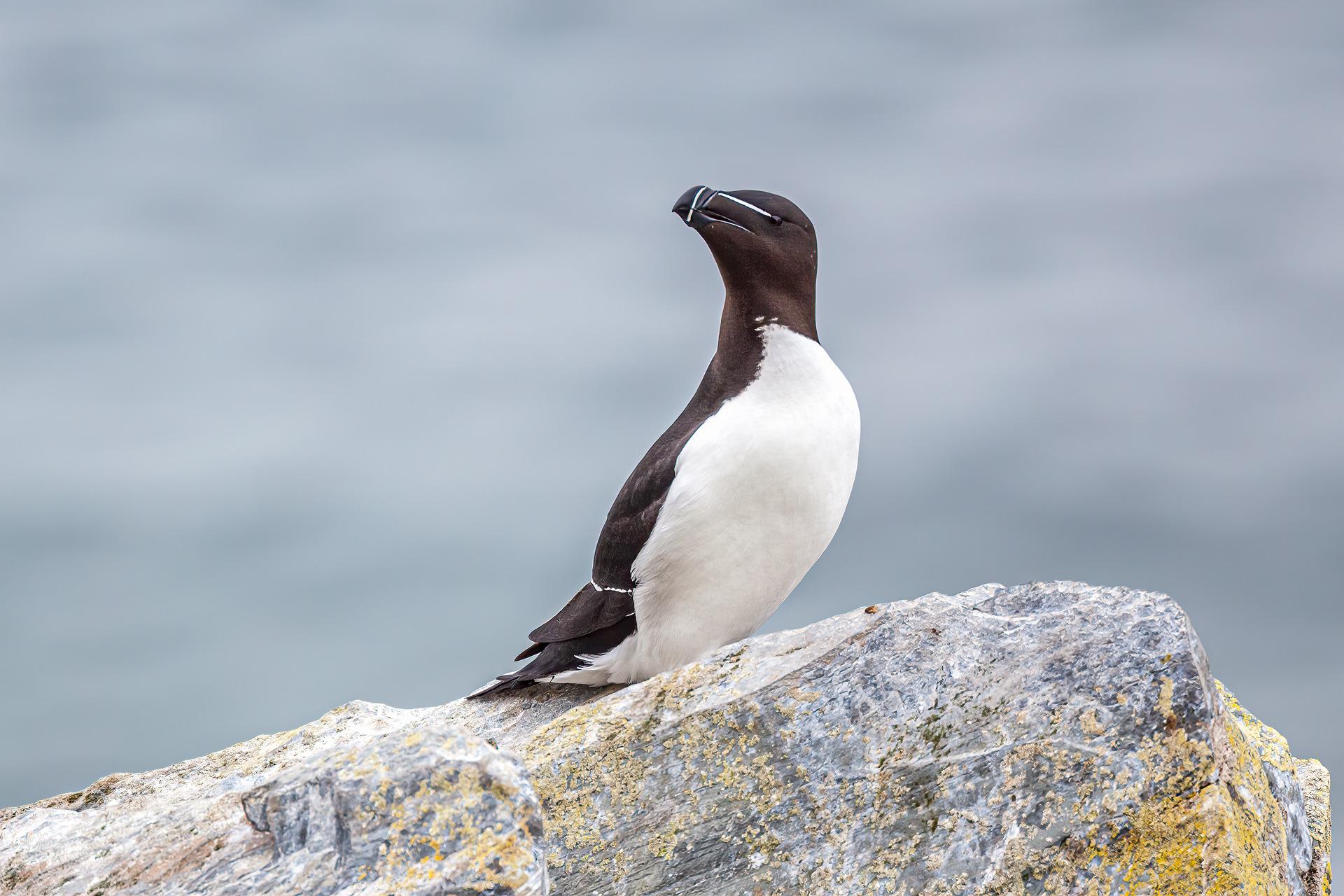Looking at any of the individual species within the Auk family, you might just mistake them for penguins. Consisting of the extinct Great Auk as well as almost two dozen living members, the Alcidae family includes auklets, guillemots, murres, puffins, and murrelets.
Smaller than the larger examples from the penguin family, these two groups are otherwise quite similar in appearance. Like penguins, Auks have an upright body type. Most auks are predominantly black and white in color. Both families are also very obviously built for diving for fish. Unlike penguins, however, most Auk species can still fly, though they are more at home in the water than the sky.
Like penguins, Auks are so well adapted for life at sea that certain species will spend most of their lives in the water. As such, they have become emblems of ocean conservation.
Auk Symbolism and Meaning
As stated above, Auks often represent the wild natural beauty of the ocean and the importance of preserving this resource. This is magnified when discussion turns to the Great Auk which became extinct in the mid-nineteenth century. This bird’s extinction is largely attributed to human intervention and, like the legendary Dodo bird, has become a symbol of the loss of animal life which occurs when humans hunt indiscriminately or destroy natural habitats.
Auks are known to be monogamous and prone to forming intense lifelong pair bonds. For this reason, the Auk is symbolic of romance, faithfulness, and family.
Because Auks are talented deep sea divers, these birds may represent the things which lie beneath the surface of a subject. Rather than prejudging on first impressions, the Auk reminds us to dive deeper in order to learn the truth.
Some species of Auk are able to recognize one another by their unique voices. These species will call back and forth to each other while fishing at sea. For this reason, the Auk may represent communication.
Auks, including to its own detriment the Great Auk, are largely unafraid of humans. Certain species can apparently be approached by humans without becoming alarmed. This makes them an easy target for hunting but also a fascinating subject of study. This trait connects the Auk with trust, naivete, and openness.
Auk Native American Symbolism
Auks and puffins are important figures in several Native American tribes. One Winnebago myth, which we will discuss in detail later, cites the Auk as the origin of the markings on the surface of the moon.
Ancient burial sites in Newfoundland suggest that early Native American cultures found ritualistic purposes for the bones, beaks, and feathers of Auks.

Some Native groups attribute to Auks and puffins the ability to control the weather, conjure storms, or protect humans. A Tlingit myth demonstrates the power of the puffin by describing how a tribe of puffins once rescued the drowning daughter of a great chief. In many traditions, these birds are powerful guardian spirits.
Auk Celtic Symbolism
In Celtic traditions, the Auk represents shapeshifting, witchcraft, sorcery, and storms. This creature is thought to be the inspiration for a fearsome cryptid known as the “Boobrie.”
The tragic story of the extinction of the Great Auk in the British Isles, which we will discuss further in the mythology and folklore section, also connects auks with conservation and the dangers of overhunting, ignorance, and superstition.
Auk in Dreams
Dreaming of an Auk may feel like an exceptionally mysterious experience. Living most of their lives at sea, most people never come face to face with these enigmatic seafarers. If you’ve been dreaming of an Auk, you may want to examine whether you are on a path which favors your personal strengths.
The Auk is largely clumsy on land and generally not the strongest in flight, however in the blue depths of the ocean this bird is without parallel. Examine whether you are forcing yourself to act as a “flyer” when you ought to be a “swimmer.” That is, follow your abilities and find a path which highlights and celebrates them.
Dreaming of a puffin, specifically, might denote loneliness or a desire to connect with someone. These birds are very monogamous, so a puffin dream might mean that it’s time to put yourself out there and search for “the one.”
Auk Encounters and Omens
Auk encounters are rare except for along the rocky coasts where these birds build their nests and rear their young. If you’ve encountered an Auk, you should feel lucky to witness such a unique and special member of the animal kingdom.
Auk encounters, as rare as they are, symbolize trust and open-mindedness. In the case of the Auk, being too trusting can be dangerous, however anyone who gets close to these birds is quite lucky that they are so willing to allow humans to approach. An Auk encounter is a good opportunity to consider the kinds of people who you allow to get close to you. Are they close because they want to appreciate you in all of your uniqueness? Or, do they approach you in order to take advantage of your open heart? The Auk reminds us that trust is a double-edged sword.

Auk in Mythology & Folklore
Below are just a few of the most fascinating stories and myths which feature the Auk!
Native American Mythology:
The extinct Great Auk is believed to have played an important role in the lives of the so-called “Maritime Archaic Indians” of Port au Choix. This Archaeological sight has provided a wealth of insight into the lives of hunter-gatherer-fisher societies who made there way to this northern peninsula of Newfoundland many thousands of years ago.
Amongst the artifacts found at the Port au Choix archaeological site are a number of pieces of evidence which indicate that the Great Auk was once an important part of the lives of the people who once lived there. Amongst the human burial sites found in Port au Choix, many were discovered with the bones of the Great Auk, and other seabirds, preserved within their graves.
One of the Maritime Archaic Indian gravesites was even found to contain over two hundred Great Auk beaks. The person buried within this grave appears to have been interred with a garment made of Great Auk skins and adorned with the beaks of this extinct bird.
The sheer quantity of Auk bills used in this garment suggests that this bird played an important spiritual role in the lives of the people of this ancient settlement. The burial of Auk bones and beaks with the remains of humans may imply that the Auk was protective or guiding spirit which accompanied people into death.
The Auk features in a myth of the Winnebago Native American culture, despite the fact that these birds are not found in the regions from which the Winnebago people originate. In this story, a young man named Auk and a young man named Shell Spitter live in the same village. Shell Spitter is so-named because whenever he speaks, valuable shells fly from his mouth and the people all clamor to pick them up. Auk was slower than the other villagers and never managed to grab any shells.
One day Shell Spitter met a pair of sisters whom he wanted to make his wives. He told them to wait by the river and call out to Auk to carry them across to the village. When the sisters came, Auk did not answer their call. So, the sisters tried calling for Shell Spitter. When Auk heard this name, he formed an idea. Filling his mouth with shells from his necklace, Auk convinced the sisters that he was their betrothed.
The trio were happy together for a short while, but eventually the real Shell Spitter appeared. When he spit his shells, Auk tried his best to grab some but was beaten by the stronger villagers who wrestled them from his grip. The sisters thought that Auk was pathetic, so they rejoined Shell Spitter and became his wives. Furious, Auk beheaded all three of them and walked through the village with the three heads in his hands. Soon, though, Auk had to flee.
The people of the village were angry that he had killed Shell Spitter and his wives. So, Auk transformed into a bird, an Auk specifically, and flew to the moon to hide. There, he was safe and could not be lured back down to earth no matter how hard the villager’s tried. To this day, Auk lives on the moon in the form of a bird, hiding from the justice that his village would deliver for his crimes.
Scottish Folklore:
Great Auks were once abundant on the shores of the British Isles. Centuries of hunting these defenseless and clumsy birds had made them extremely rare by the early nineteenth century. In a narrative which calls to mind the ill-fated Dodo bird, Great Auks were fearless around humans and would scarcely even flee when hunted. Because these birds were so easy to catch and so large, they made a fine source of meat and were hunted voraciously.
In 1844, a trio of sailors spotted what would be the last Great Auk ever found on the British Isles. Perhaps because they realized the rarity of what they had found, the sailors captured and bound the animal. For three days the last Great Auk of Britain sat in captivity aboard their boat. On the fourth day, however, a brutal storm rolled in. Superstitious, the sailors began to suspect that the captive Auk had summoned this storm to destroy its captors. Fearing that the bird was a shapeshifting witch, the men beat it to death. No Great Auk was ever found on the British Isles again and just a few years later the very last global specimen of the species was killed as well.

The Great Auk’s reputation for witchcraft persists in Scotland despite its extinction. The “Boobrie” is second only to the Loch Ness Monster in terms of Celtic cryptids. Early reports of the Boobrie seem to begin in the late nineteenth and early twentieth century, suspiciously near to the period directly following the last recorded Great Auks in the region.
The Boobrie is said to be a gigantic shapeshifting sea bird which can assume the form of a horse or an insect at will. Sightings indicate that the Boobrie is large enough to snatch up cattle and suck the blood from horses. The haunting cry of the Boobrie has connected this creature to the Bittern, a living migratory bird which is very rarely found in Scotland and is known for its distinctive and strange cry. B
ased on the reported size of the Boobrie, however, and the fact that it is usually sighted near the sea or near one of Scotland’s many “lochs,” the Great Auk has been suggested as an origin for this legend. Great Auks are known to have stood nearly three feet high and would certainly look out of place on the rocky shores of modern Scotland depsite the fact that they were once plentiful there. If the Boobrie truly is a Great Auk, it is a strange and tragic irony that it has once again been accused of being a shapeshifting menace, long after the same suspicion contributed to its apparent extinction.
Auk Spirit Animal
If the Auk is your spirit animal, then you are likely a reserved and introverted person who prefers the company of family to the chatter of strangers or acquaintances. People with this spirit animal are independent and capable of enjoying their own company for long stretches of time, however they do eventually tend to grow lonely. For the Auk spirit animal, the only relationship who truly matters is their “soul mate.” The one person who truly gets them.
Despite being more comfortable alone, the Auk spirit animal tends to be kind and welcoming towards others owing to its empathetic nature. It’s important that people with this spirit animal learn to draw boundaries and protect their alone time!

Auk Totem Animal
The Auk totem is associated with truth. People with this totem animal tend to be very curious and enjoy investigating situations. Unlikely to be satisfied by the simplest explanation, people with the Auk totem always dive for the heart of the issue. This appetite for truth and knowledge contributes to an especially sharp sense of justice. The Auk totem animal does not abide liars.
Auk Power Animal
The Auk power animal is associated with intuition. People with this power animal are very skilled at sensing the course of events and drawing reasonable conclusions. This may fail when it comes to other people, as the Auk tends to give others the benefit of the doubt. Because the aforementioned sense of justice, this benefit of the doubt disappears once a person has lost the Auk’s trust. People with this power animal are stubborn and can hold a grudge for a long time.
Auk Tattoo Meaning
An Auk tattoo is an excellent choice for someone who wants to symbolize the power and beauty of the oceans and their ecosystems. A Great Auk tattoo may also represent the importance of conservation.
An Auk tattoo could also be chosen to symbolize romance, stability, trust, the occult, or curiosity.
Conclusion
The Auk is one of those special animals whose freedom and wildness seems to embody all of the beauty of nature within one feathered form. Thanks to these birds, we have learned hard lessons as a species and must do what we can to prevent all Auks from joining the Great Auk in its unfortunate fate. With enough appreciation and responsibility, we can preserve the incredible beauty of this species without whom the landscape of our ocean-covered planet would never be quite the same.

